Exercise classes help sufferers ease arthritis pain
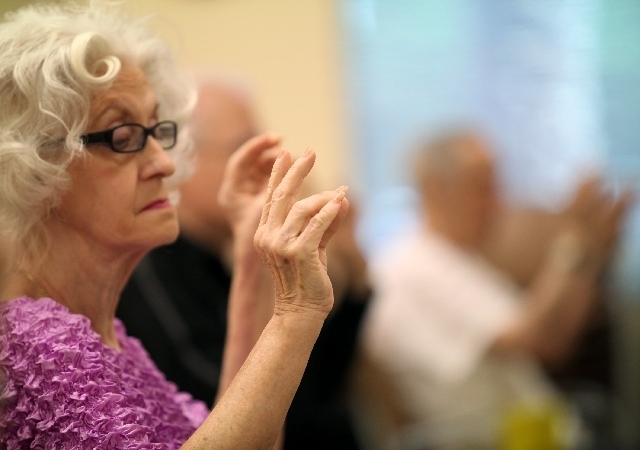
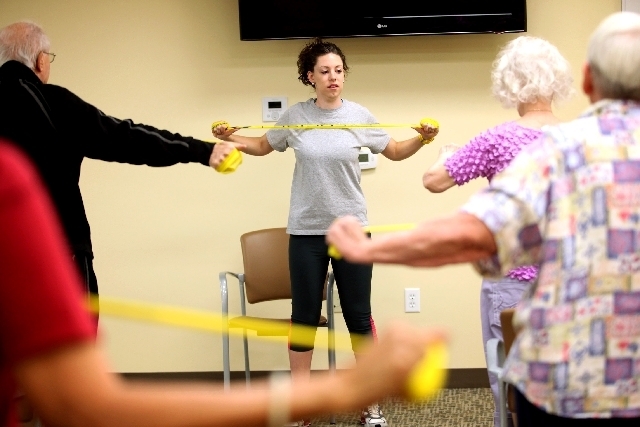
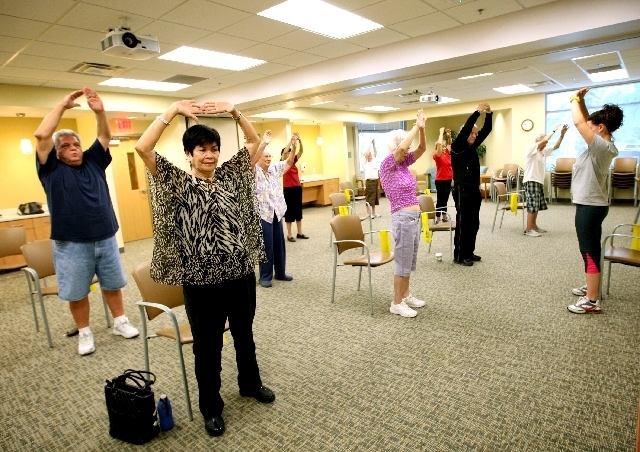
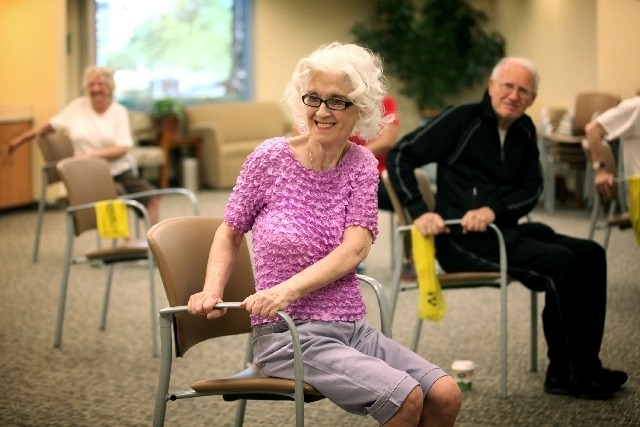

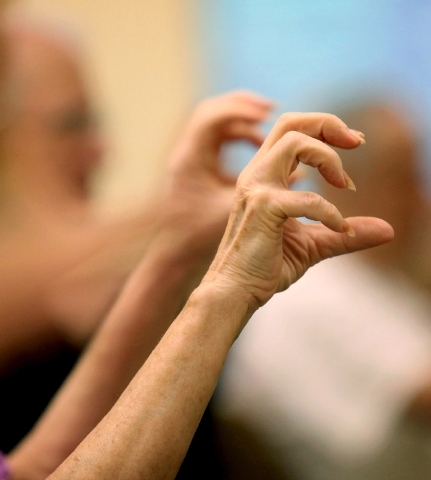
Betty Sue Bailey, 77, has lost a few inches since her diagnosis about 10 years ago with osteoarthritis, a degenerative joint disease. But she’s standing up to the disease with help from the Arthritis Foundation exercise program at the Southwest Medical Associates Lifestyle Centers.
“It’s mostly mental,” she said of the lift she’s gotten from the classes, which are evidence-based, derived from research done by the foundation in conjunction with the Centers for Disease Control and Prevention. “I don’t sit on my butt as much as I used to, even when I’m home. If I’m sitting watching a movie, I’ll do some of our exercises, twist from one side to the other, or move my legs. Same way when I do something on the computer, I’ll do something like moving my fingers.”
According to the Arthritis Foundation, a nonprofit focused on the prevention, control and cure of arthritis through research, public policy, public health and services, osteoarthritis is the most common type of arthritis. It afflicts more than 27 million Americans, according to the CDC, with knee osteoarthritis alone possibly developing in 1 in 2 people.
The disease may affect the hands, knees, hips, low back, neck and feet. Symptoms include joint pain, aching, stiffness and swelling. It prevents people from moving — and working. It can require surgery and joint replacement. And, the Arthritis Foundation pegs it as the No. 1 leading cause of years lived with a disability in the U.S.
“It depends on which joints are involved,” explained Dr. Eric L. Matteson, chairman of the Division of Rheumatology at the Mayo Clinic in Rochester, Minn. “For example, people who have osteoarthritis of the knee and hip will, over time, experience a lessening of their functional abilities, their ability to walk and even may experience pain at rest.”
Bailey’s diagnosis arrived even before the pain did. At the doctor’s office for a general checkup, she discovered that she’d shrunk by an inch. That led to a discussion, and further testing.
“If I hadn’t had it diagnosed then, my doctor said I would probably be slump-shouldered,” she said. “I do have arthritis in my knees. I don’t go up and down the stairs too much if I can help it.”
She can still maneuver, she added, thanks to a regimen of vitamins, calcium and a shot every six months. Not to mention a shot of fun for an hour on Tuesdays and Wednesdays, when she attends her exercise classes, where wisecracks about knee pain can erupt any time.
And, when instructor Sarah Brabbs declares that she’s forgotten the next exercise, the peanut gallery of students is often quick with a retort: “Wait till you get to be our age!”
The classes, along with other forms of exercise, are a top line of defense for many sufferers. Arthritis Foundation classes are free, open to everyone, and take place at local sites on land and in the water, including the Henderson pool, said Crystal Schulz, community development manager at the Nevada office of the Arthritis Foundation. There’s even a Walk with Ease program, akin to a walking club, held three days a week. Approximately 16 Nevada programs serve 400 attendees, including spouses and family members of people with osteoarthritis.
Arthritis Foundation classes are “evidence-based, so they’re researched and proven to reduce pain, reduce fatigue, increase energy and increase flexibility,” Schulz explained.
“They’re very gentle exercises, but that’s not to say that they don’t get these people in a workout, sweating,” she added. “They can be high intensity but low impact.”
Among the workout warriors in her class, said Bailey: her instructor’s grandmother, who attends every week.
Osteopathic physician David J. Park is a professor at Touro University Nevada College of Osteopathic Medicine, chairman of its Primary Care Department and program director of Valley Hospital Medical Center’s Family Medicine Residency. He estimated that about 20 percent of his patients suffer from the disease. And an increasing population of older patients is leading to a rise in the disease because it is age-related.
But osteoarthritis may not just be your grandmother’s disease anymore.
“It’s not just the degenerative disease of the old,” he said. “It’s an interplay of multiple factors such as mechanical trauma, whether it’s a major trauma or repetitive micro trauma. It may be due to our general health and the cellular response in our bodies. It may be due to some genetic predisposition. It may be due to our posture, the way we walk, the balance in our body, in our spine and in our joints. If we start hitting those multiple factors early on for prevention, then we may be able to avoid having osteoarthritis in our older years.”
But brushing the disease off as a necessary evil is an all-too-common hindrance. Schulz said that people typically wait 10 years before seeing the doctor. Park’s patients often don’t even bring it up unless he asks them, he said.
“They’ll say, ‘Yeah, I have that, but it’s been a long time, it’s probably just arthritis,’ ” he observed. “Then I’ll say, ‘Maybe it’s not just arthritis, and even if it is arthritis, let’s take care of that.’ I don’t want my patients living in pain.”
Patient history, physical examination, X-rays, and possibly additional blood testing all help Park to determine whether the culprit is osteoarthritis. Slowing down the disease is the goal, once it’s detected.
While curing it may not yet be an option, the very nature of the disease itself, and possible sources of hope for the future, are still under the microscope, Matteson said. He cited recent Mayo Clinic research in which uric crystals — the stuff of gout — were taken from the joints of patients with advanced osteoarthritis. Those patients hadn’t had a history of gout or high uric acid.
Another substance under the microscope: tanezumab, a drug that’s improving both pain and function in clinical trial patients. It’s an antibody that inhibits the stimulation of pain receptors. Another potentially hope-inducing protein, lubricin, is showing the promise of slowing down arthritis when injected into the knees of mice.
Controlling the pain, these days, runs the gamut from injections of complex proteins for lubrication and pain-relieving corticosteroids, to the application of heat, the plentiful use of acetaminophen and ibuprofen, topical nonsteroidal anti-inflammatory drugs from a compound pharmacy, and certain kinds of manual adjustments. Surgery and joint replacement are a last resort.
Dr. Rebecca Edgeworth, medical director of Volunteers in Medicine of Southern Nevada, recalled one patient who arrived on her doorstep when he was about 60 years old. Like many of the charitable medical clinic’s patients, he was between jobs, losing mobility, and trying to hold the pieces together.
With her encouragement, he sought out a gym membership discount, based on the fact that he also suffered from diabetes. Swimming, water aerobics, an injection from an orthopedic physician and a daily anti-inflammatory got him on a roll.
“The more weight he lost and the more his knee felt better, the more active he was able to be,” she said.
Park said he might even recommend an approach such as t’ai chi, along with other regular physical exercise. He cited a recent study in which 40 osteoarthritis patients performed the ancient Chinese meditative exercise system for 60 minutes, twice a week, and experienced significantly greater pain reduction and functionality than the control group that stretched and received education. In fact, he added, the American College of Rheumatology actually recommends acupuncture for some patients, when total knee replacement isn’t an option.
But an often neglected remedy is, simply, weight loss, according to Matteson.
“A little weight goes a long ways,” he said. “Even for the average person, if they lose about 10 pounds, when we think about the loading pressures on the knee, just taking a step, that translates to about a loss of 30 pounds.”












